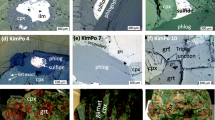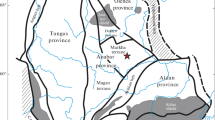Abstract
Diamond-bearing eclogites are an important component of the xenoliths that occur in the Mir kimberlite, Siberian platform, Russia. We have studied 16 of these eclogite xenoliths, which are characterized by coarse-grained, equigranular garnet and omphacite. On the basis of compositional variations in garnet and clinopyroxene, this suite of eclogites can be divided into at least two groups: a high-Ca group and a low-Ca group. The high-Ca group consists of high-Ca garnets in equilibrium with pyroxenes that have high Ca-ratios [Ca/(Ca+Fe+Mg)] and high jadeite contents. These high-Ca group samples have high modal% garnet, and garnet grains often are zoned. Garnet patches along rims and along amphibole- and phlogopite-filled veins have higher Mg and lower Ca contents compared to homogeneous cores. The low-Ca group consists of eclogites with low-Ca garnets in equilibrium with pyroxenes with a low Ca-ratio, but variable jadeite contents. These low-Ca group samples typically have low modal% of garnet, and garnets are rarely compositionally zoned. Three samples have mineralogic compositions and modes transitional to the high- and low-Ca groups. We have arbitrarily designated these samples as the intermediate-Ca group. The rare-earth-element (REE) contents of garnet and clinopyroxene have been determined by ion microprobe. Garnets from the low-Ca group have low LREE contents and typically have [Dy/Yb]n < 1. The high-Ca group garnets have higher LREE contents and typically have [Dy/Yb]n > 1. Garnets from the intermediate-Ca group have REE contents between the high- and low-Ca groups. Clinopyroxenes from the low-Ca group have convex-upward REE patterns with relatively high REE contents (ten times chondrite), whereas those from the high-Ca group have similar convex-upward shapes, but lower REE contents, approximately chondritic. Reconstructed bulk-rock REE patterns for the low-Ca group eclogites are relatively flat at approximately ten times chondrite. In contrast, the high-Ca group samples typically have LREE-depleted patterns and lower REE contents. The δ18O values measured for garnet separates range from 7.2 to 3.1‰. Although there is a broad overlap of δ18O between the low-Ca and high-Ca groups, the low-Ca group samples range from mantle-like to high δ18O values (4.9 to 7.2‰), and the high-Ca group garnets range from mantle-like to low δ18O values (5.3 to 3.1‰). The oxygen isotopic compositions of two of the five high-Ca group samples and four of the eight low-Ca group eclogites are consistent with seawater alteration of basaltic crust, with the low-Ca group eclogites representative of low-temperature alteration, and the high-Ca group samples representative of high-temperature hydrothermal seawater alteration. We interpret the differences between the low- and high-Ca group samples to be primarily a result of differences in the protoliths of these samples. The high-Ca group eclogites are interpreted to have protoliths similar to the mid to lower sections of an ophiolite complex. This section of oceanic crust would be dominated by rocks which have a significant cumulate component and would have experienced high-temperature seawater alteration. Such cumulate rocks probably would be LREE-depleted, and can be Ca-rich because of plagioclase or clinopyroxene accumulation. The protoliths of the low-Ca group eclogites are interpreted to be the upper section of an ophiolite complex. This section of oceanic crust would consist mainly of extrusive basalts that would have been altered by seawater at low temperatures. These basaltic lavas would probably have relatively flat REE patterns, as seen for the low-Ca group eclogites.
Similar content being viewed by others
Author information
Authors and Affiliations
Additional information
Received: 10 July 1995 / Accepted: 17 May 1996
Rights and permissions
About this article
Cite this article
Beard, B., Fraracci, K., Clayton, R. et al. Petrography and geochemistry of eclogites from the Mir kimberlite, Yakutia, Russia. Contrib Mineral Petrol 125, 293–310 (1996). https://doi.org/10.1007/s004100050223
Issue Date:
DOI: https://doi.org/10.1007/s004100050223




